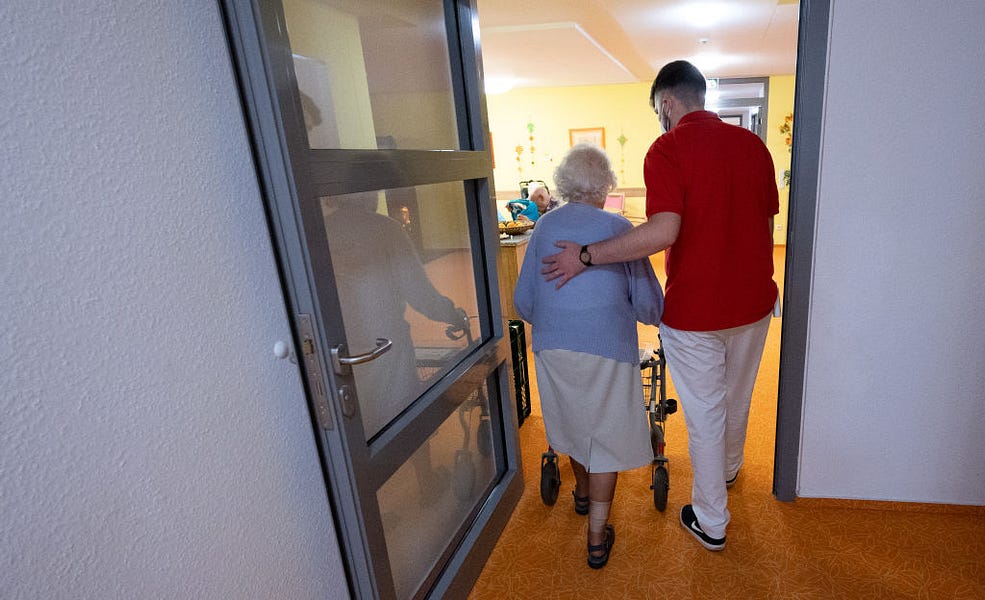It’s looking increasingly unlikely that the Senate will pass President Biden’s Build Back Better social spending plan before the end of the year. Since the House version passed last month, there has been heightened scrutiny on the bill’s largest spending provisions, such as universal child care, green energy, and paid family leave, all government expansions that will grow ad infinitum once passed and signed into law. In fact, the Congressional Budget Office recently released the true effect of the bill’s provisions if they are all made permanent: $3 trillion added to the deficit over 10 years, rather than adding $365 billion to the deficit if all programs are allowed to lapse as written.
There are other provisions in the bill that are destructive in their own right, even if they have received less attention. While establishing the aforementioned programs would place additional stress on the government balance sheet, it has always been the growth in health care spending—especially in Medicare and Medicaid—that represents the greatest threat to America’s bottom line.
The most overlooked but consequential piece of the bill’s $1.85 trillion price tag is a $150 billion outlay for long-term care (LTC)—most of which is earmarked for bolstering home- and community-based services (HCBS) in Medicaid.
What’s worse, BBB also has two unfunded mandates related to long-term care staffing levels that will have far-reaching implications for the industry and ultimately, what taxpayers will have to pay.
Home Care in the BBB Act
Long-term care advocates have long sought more funding through Medicaid, which is the single largest payer of such services in the U.S. They want to use this funding to increase access to services for beneficiaries and to increase pay among LTC workers, especially direct care workers who earn lower wages than their nurse counterparts. What is paradoxical about this is that Medicaid, by design, has the lowest provider-reimbursement rates of any payer because a portion of Medicaid spending is covered by state governments that must balance their budgets. Thus, reimbursing at rates comparable to Medicare or private insurance would crowd out other spending priorities in each state. This pressure on state legislatures to keep reimbursement rates as low as possible will not go away, especially as temporary COVID funding begins to dry up.
The reimbursement rates in Medicaid lie at the heart of the problems with BBB’s LTC funding. The bill attempts to extend home- and community-based services to hundreds of thousands currently on waiting lists while simultaneously recognizing that providers must hire more workers with meager Medicaid rates and a historically tight labor market. Therefore, while the bill provides an additional 6 percent match to provide services to those on waiting lists, it also requires states to develop processes to increase direct care worker pay. While the goals of providing more services and increasing worker pay are admirable, pursuing one goal comes at the cost of the other.
Congress could propose alternative ways to increase the uptake of long-term care insurance or find ways for people to save through their working lives for LTC costs, which come almost exclusively in old age. As a starting point, Congress could enact several promising proposals released in 2013 by the Commission on Long-term Care. One particularly interesting proposal would allow individuals to take out a long-term care insurance plan as part of applying for Social Security benefits at retirement, in exchange for forgoing assistance from Medicaid in the future. Because LTC insurance allows beneficiaries greater access to a variety of long-term care services while paying providers higher reimbursement rates, this would help solve the two problems advocates are targeting: ensuring more people have access to the services they need while also paying LTC workers higher wages.
Staffing Regulations
It would be bad enough if the House bill stopped there. But the bill’s unfunded mandates on the industry will only exacerbate the financial strain on nursing home providers.
First, Section 30720 of the bill requires a study on minimum staff-to-resident ratios for professions such as registered nurses, licensed vocational nurses, and certified nursing assistants in nursing homes. One year following release of the study, the HHS Secretary is required to implement a new standard that will almost surely be an increase from the typical hours of direct care per resident per day. The American Health Care Association and National Center for Assisted Living (AHCA/NCAL), which represents more than 14,000 LTC facilities nationwide, assumes the new standard will be about four hours of direct care per resident per day, given most studies suggest this to be the standard. If the HHS study concludes that the new federal standard should be four hours, it would represent a 25 percent staff increase of 150,000 nurse professionals at a cost of $10.7 billion annually—all at a time when recruiting and retaining workers in LTC facilities is harder than ever due to the pandemic.
On the surface, intuition suggests more staff provides higher quality care to residents. But a potential standard increasing staffing levels is problematic in a number of ways. Other than an exemption for rural facilities who face higher barriers to adequately recruit staff, the bill’s language does not account for patient mix at each facility. For example, if two facilities each have 100 residents, but one has 50 residents with multiple chronic conditions and the other has only 25, each facility requires a different mix of skill levels among staff.
In addition, the staff ratio requirement fails to recognize that additional staff accomplishes little if the contextual conditions in nursing homes do not leverage such staff. Parameters such as a shared common purpose and philosophy of care among staff, good communication, professional autonomy, and a safe team culture are needed to unlock the potential of larger and more diverse staff teams.
Finally, requirements that increase staff without additional funding will force facility operators to find cuts elsewhere to keep their doors open. As the COVID pandemic has shown, cutting corners on supplies and infection control measures will put residents at greater risk.
Notably, the Senate Finance Committee’s preliminary version of BBB keeps the staff-to-resident ratio study, but removes the unfunded mandate that implements the study’s new ratio.
The other unfunded mandate is buried under provisions approved by the House Ways and Means Committee. Section 132000 of the House bill requires facilities keep a registered nurse on premises around the clock to receive federal reimbursement, an increase from the current eight-hour requirement. Again, the goal appears laudable; one could assume having an experienced RN on staff at all times would increase the safety and quality of care for residents.
For smaller facilities, however, this new standard is far beyond what is necessary to provide a continuum of care. For many residents, an experienced medical provider is not as important or necessary as a low-wage but experienced and caring personal care worker helping bathe them. Contrary to popular belief, many residents don’t require high-intensity medical care. In fact, many residents are in nursing homes simply because they would otherwise be stuck on waiting lists for home- and-community based services in Medicaid.
For this provision, AHCA/NCAL estimates facilities would need to hire 21,000 additional RNs at a cost of $2.5 billion per year.
Unlike the other staffing requirement, the Senate Finance Committee’s bill text kept this provision as written in the House bill.
Doubling Down on a Failed System
The reconciliation bill’s long-term care provisions suffer from one common malady: They provide conventional-wisdom “solutions” that perpetuate a failed system of care for the frail and elderly.
In BBB, Congress overlooked an important component to a nursing home residents’ well-being: social interaction. In fact, based on a meta-analysis of studies on nursing home staffing worldwide, the few studies that examined the levels of activity staff—those who plan and execute social activities among residents—showed a consistently positive relationship on resident outcomes. And the effect going forward will likely be stronger as nursing homes emerge from pandemic-era lockdowns.
BBB is the manifestation of what most long-term care advocates think are solutions: spend more money for Medicaid and more aggressively regulate nursing homes. But the evidence strongly suggests that outcomes for those who receive LTC through Medicaid are worse than those who have LTC insurance or self-pay, if for nothing more than Medicaid often poorly assigns people to the types of care that fits their needs. Nursing homes are more heavily regulated than they have ever been yet care quality and outcomes have not improved. In fact, recent investigations have exposed more dire problems, including nursing homes subverting the federal nursing home ratings system and appealing inspection violations in secret with no input from residents who’ve been harmed.
A better way to improve LTC is to help seniors transition to home- and community-based services outside of the Medicaid program. For starters, increasing both awareness in and the affordability of long-term care insurance, especially for those in the lower-middle and middle classes, will reduce the strain on Medicaid and provide the flexibility for people to receive care in settings most attuned to their needs. And a greater focus on social connections for seniors to remain at home or in the community—connections which were severed under COVID protocols and lockdowns—would yield the biggest bang for the buck. No billions in social spending required.
Gregg Girvan is a health care research fellow at the Foundation for Research on Equal Opportunity






Please note that we at The Dispatch hold ourselves, our work, and our commenters to a higher standard than other places on the internet. We welcome comments that foster genuine debate or discussion—including comments critical of us or our work—but responses that include ad hominem attacks on fellow Dispatch members or are intended to stoke fear and anger may be moderated.
With your membership, you only have the ability to comment on The Morning Dispatch articles. Consider upgrading to join the conversation everywhere.